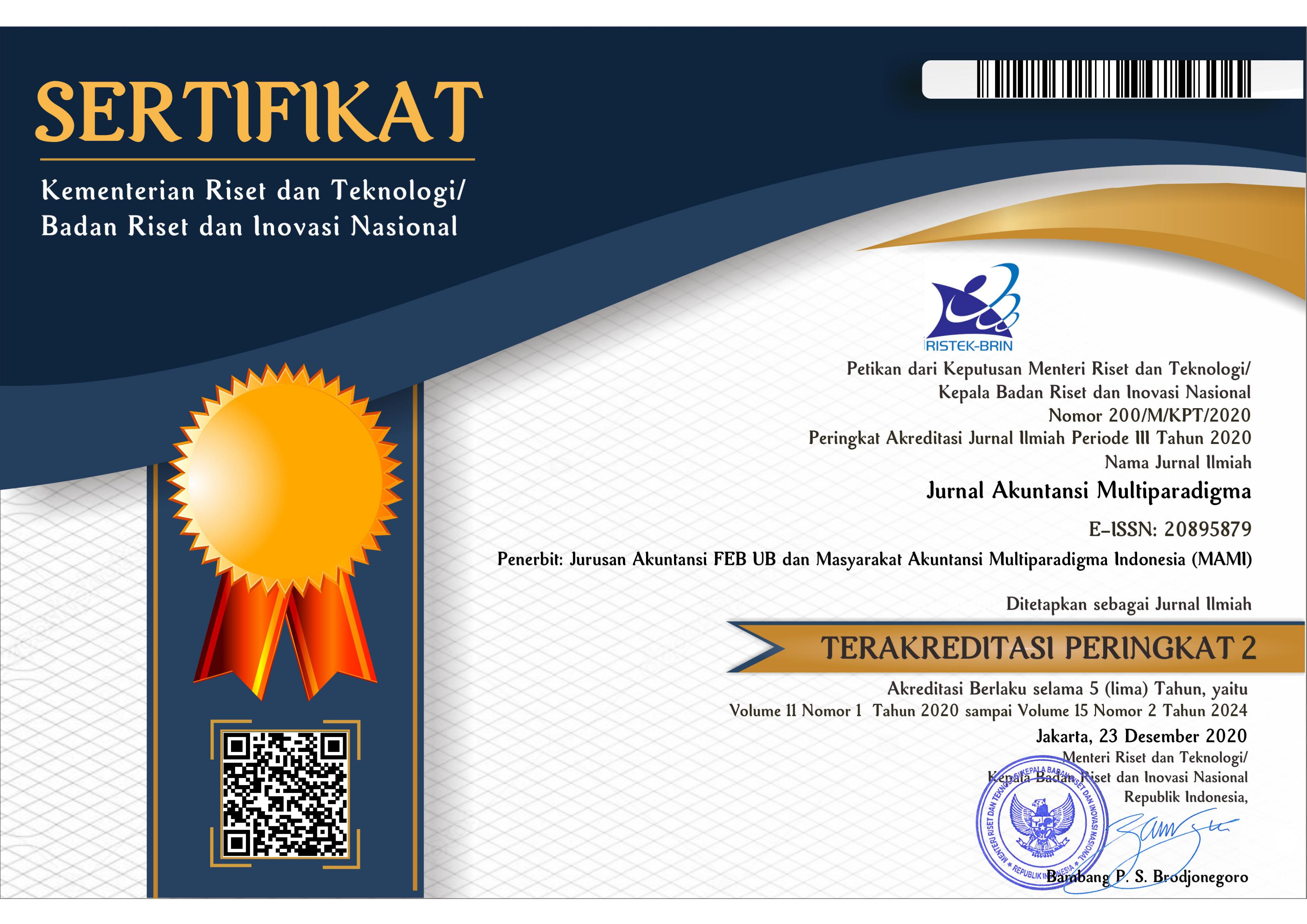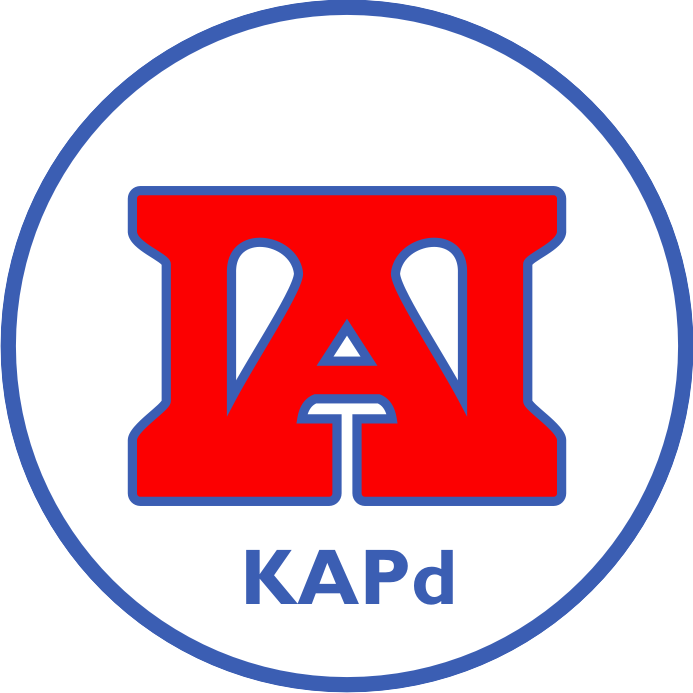DETERMINAN OPTIMALISASI PENGGUNAAN ASET TETAP PEMERINTAH DAERAH
Abstract
Abstrak: Determinan Optimalisasi Pengunaan Aset Tetap Pemerintah Daerah. Penelitian ini bertujuan untuk menganalisis determinan optimalisasi penggunaan aset tetap Pemerintah Daerah pada Pemerintah Kabupaten Semarang. Penelitian ini menggunakan metode analisis Structural Equation Modeling-Partial Least Squares (SEM-PLS) pada 46 Organisasi Perangkat Daerah (OPD) Pemerintah Kabupaten Semarang. Penelitian ini menemukan bahwa perencanaan kebutuhan dan inventarisasi merupakan faktor terpenting dalam optimalisasi aset tetap. Optimalisasi aset tetap hanya dapat tercapai jika dimulai dengan perencanaan stratejik yang tepat dan sesuai dengan tujuan organisasi. Selain itu, inventarisasi wajib dilakukan agar Pemda mempunyai pangkalan data terkini terkait aset-asetnya.
Abstract: Determinants of Optimizing the Use of Local Government Fixed Assets. This study aims to analyze the optimal determinants of the use of fixed assets of the Regional Government in the Semarang District Government. This study uses the analysis method of Structural Equation Modeling-Partial Least Squares (SEM-PLS) in 46 Regional Government. This study finds that demand planning and inventory are the most important factors in fixed assets optimization. It can only be achieved if starts with the right strategic planning and in accordance with the goals of the organization. In addition, the inventory must be carried out so that the regional government has the latest database of its assets.
Keywords
Full Text:
PDFReferences
Abdullah, S., Razak, A. A., & Pakir, A. H. K. (2011). The Characteristics of Real Estate Assets Management Practice in the Malaysian Federal Government. Journal of Corporate Real Estate, 13(1), 16-35. https://doi.org/10.1108/14630011111120323
Amirya, M., Djamhuri, A., & Ludigdo, U. (2014). Pengembangan Sistem Anggaran dan Akuntansi Badan Layanan Umum Universitas Brawijaya: Perspektif Institusionalis. Jurnal Akuntansi Multiparadigma, 3(3), 343-356. http://doi.org/10.18202/jamal.2012.12.7166
Atmo, G. U., Duffield, C., Zhang, L., & Wilson, D. I. (2017). Comparative Performance of PPPs and Traditional Procurement Projects in Indonesia. International Journal of Public Sector Management, 30(2), 118-136. https://doi.org/10.1108/IJPSM-02-2016-0047
Brinkerhoff, D. W., & Wetterberg, A. (2013). Performance-based Public Management Reforms: Experience and Emerging Lessons from Service Delivery Improvement in Indonesia. International Review of Administrative Sciences, 79(3), 433–457. https://doi.org/10.1177/0020852313491059
Brookes, M., & Altinay, L. (2017). Knowledge Transfer and Isomorphism in Franchise Networks. International Journal of Hospitality Management, 62, 33-42. https://doi.org/10.1016/j.ijhm.2016.11.012
Byrne, M. (2016). ‘Asset Price Urbanism’ and Financialization after the Crisis: Ireland's National Asset Management Agency. International Journal of Urban and Regional Research, 40(1), 31-45. https://doi.org/10.1111/1468-2427.12331
Chen, J., & Imam, P. (2014). Consequences of Asset Shortages in Emerging Markets. Macroeconomics and Finance in Emerging Market Economies, 7(1), 4-35. https://doi.org/10.1080/17520843.2013.809007
Denman, B. D., & James, J. (2016). Cultural Ecology and Isomorphism Applied to Educational Planning in China’s Inner Mongolia: A New Rubric. International Journal of Comparative Education and Development, 18(1), 40-52. https://doi.org/10.1108/IJCED-10-2015-0003
DiMaggio, P. J., & Powell, W.W. (1983). Institutional Isomorphism and Collective Rationality in Organitation Fields. American Sociological Review, 48(2), 147–160. https://doi.org/10.2307/2095101
Doherty, N.. F., McConnell, D. J., & Ellis‐Chadwick, F. (2013). Institutional Responses to Electronic Procurement in the Public Sector. International Journal of Public Sector Management, 26(6), 495-515. https://doi.org/10.1108/IJPSM-04-2012-0048
Hanis, M. H., Trigunarsyah, B., & Susilawati, C. (2011). The Application of Public Asset Management in Indonesian Local Government: A Case Study in South Sulawesi Province. Journal of Corporate Real Estate, 13(1), 36-47. https://doi.org/10.1108/14630011111120332
Hasiara, L. O. (2012). Sikap dan Perilaku Pejabat, Unit SKPD dalam Pengelolaan APBD dan Aset Daerah. Jurnal Akuntansi Multiparadigma, 3(1), 101-110. http://doi.org/10.18202/jamal.2012.04.7147
Hormati, A. (2012). Pengujian Model Unified Theory of Acceptance and Use of Technology dalam Pemanfaatan Sistem Informasi Keuangan Daerah. Jurnal Akuntansi Multiparadigma, 3(1), 1-24. http://doi.org/10.18202/jamal.2012.04.7140
Johnson, M. (2012). A study of E‐market Adoption Barriers in the Local Government Sector. Journal of Enterprise Information Management, 25(6), 509-536, https://doi.org/10.1108/17410391211272810
Joo, S., Larkin, B., & Walker, N. (2017). Institutional Isomorphism and Social Responsibility in Professional Sports. Sport, Business and Management: An International Journal, 7(1), 38-57. https://doi.org/10.1108/SBM-03-2016-0010
Kolinug, M. S., Ilat, V. H., & Pinatik, S. (2015). Analisis Pengelolaan Aset Tetap pada Dinas Pendapatan Pengelolaan Keuangan dan Aset Daerah Kota Tomohon. Jurnal Emba, 3(1), 818-830.
Kurniati, E., Asmony, T., & Santoso, B. (2017). Kemelut Penatausahaan Aset Tetap (Dulu hingga Kini). Jurnal Akuntansi Multiparadigma, 8(3), 540-558. http://doi.org/10.18202/jamal.2017.12.7072
Latan, H., & Ghozali, I. (2016). Partial Least Squares Konsep, Metode dan Aplikasi WarpPLS 5.0. Semarang: BP UNDIP.
Lourenco, R. P. (2015). An Analysis of Open Government Portals: A Perspective of Transparency for Accountability. Government Information Quarterly, 32(3), 323-332. https://doi.org/10.1016/j.giq.2015.05.006
Nasution, E., Nasution, H, & Absah, Y. (2015). Pengaruh Manajemen Aset Terhadap Optimalisasi Aset Rumah Sakit Jiwa Daerah Provinsi Sumatera Utara. Jurnal Ekonom, 18(1),15-35
Phelps, A. (2011). Municipal Property Asset Management – A Comparative Study of UK and Russia. International Journal of Strategic Property Management, 15(4), 416-437. https://doi.org/10.3846/1648715X.2011.642537
Pilcher, R. (2011). Implementing IFRS in Local Government: Institutional Isomorphism as NPM Goes Mad? Local Government Studies, 37(4), 367-389. https://doi.org/10.1080/03003930.2011.588702
Prabowo, T. J. W., Leung, P., & Guthrie, J. (2017). Reforms in Public Sector Accounting and Budgeting in Indonesia (2003-2015): Confusions in Implementation. Journal of Public Budgeting, Accounting & Financial Management, 29(1), 104-137. https://doi.org/10.1108/JPBAFM-29-01-2017-B005
Priyono, K. (2013). Keandalan Informasi Laporan Keuangan Daerah Berbasis Akrual: Kajian Pengelolaan Aset Tetap Daerah Kabupaten Sampang. El Muhasaba: Jurnal Akuntansi, 4(1), 1-21. http://doi.org/10.18860/em.v4i1.2331
Puttick, S. (2017). ‘You’ll See That Everywhere’: Institutional Isomorphism in Secondary School Subject Departments. School Leadership & Management, 37(1-2), 61-79. https://doi.org/10.1080/13632434.2017.1293633
Randa, F., & Daromes, F. (2014). Transformasi Nilai Budaya Lokal dalam Membangun Akuntabilitas Organisasi Sektor Publik. Jurnal Akuntansi Multiparadigma, 5(3), 477-484. http://doi.org/10.18202/jamal.2014.12.5035
Rasolonjatovo, H., Lande, E., & Harison, V. (2015). Active Asset Management: Feasibility in Malagasy Municipalities. Public Money & Management, 35(6), 417-422. https://doi.org/10.1080/09540962.2015.1083686
Rymarzak, M., & Trojanowski, D. (2015). Asset Management Determinants of Polish Universities. Journal of Corporate Real Estate, 17(3), 178-197. https://doi.org/10.1108/JCRE-02-2015-0006
Sareeen, S. (2017). Who Governs Local Access in Jharkhand? Mechanisms of Access to Government Services. Forum for Development Studies, 44(2), 249-275. https://doi.org/10.1080/08039410.2016.1233135
Simamora, R., & Halim, A. (2012). Faktor-Faktor yang Mempengaruhi Pengelolaan Aset Pasca Pemekaran Wilayah dan Pengaruhnya terhadap Kualitas Laporan Keuangan Pemerintah di Kab. Tapanuli Selatan. Jurnal Ekonomi dan Bisnis, 10(1), 47-61. http://dx.doi.org/10.31941/jebi.v10i1.163
Snow, N. M., & Reck, J. L. (2016). Developing a Government Reporting Taxonomy. Journal of Information Systems, 30(2), 49-81. https://doi.org/10.2308/isys-51373
Vendramini, E., Lecci, F., & Filannino, C. (2014). When the Rubber Meets the Road: Isomorphism, Rhetoric, and (Mis)management of Interinstitutional Performance. International Journal of Public Administration, 37(13), 980-986. https://doi.org/10.1080/01900692.2014.944992
Vermeer, T. E., Patton, T. K., & Styles, A. K. (2011). Reporting of General Infrastructure Assets under GASB Statement No. 34. Accounting Horizons, 25(2), 381-407. https://doi.org/10.2308/acch-10029
Zamzami, F., & Faiz, I. (2015). Evaluasi Implementasi Sistem Pengendalian Internal: Studi Kasus pada Sebuah Perguruan Tinggi Negeri. Jurnal Akuntansi Multiparadigma, 6(1), 20-27. http://doi.org/10.18202/jamal.2015.04.6003
Zhang, H., & Hu, B. (2017). The Effects of Organizational Isomorphism on Innovation Performance through Knowledge Search in Industrial Cluster. Chinese Management Studies, 11(2), 209-229. https://doi.org/10.1108/CMS-04-2016-0076
DOI: http://dx.doi.org/10.18202/jamal.2018.04.9014
Refbacks
- There are currently no refbacks.
Copyright (c) 2018 Dwi Ratmono, Ana Rochmawati

This work is licensed under a Creative Commons Attribution-NonCommercial 4.0 International License.

















